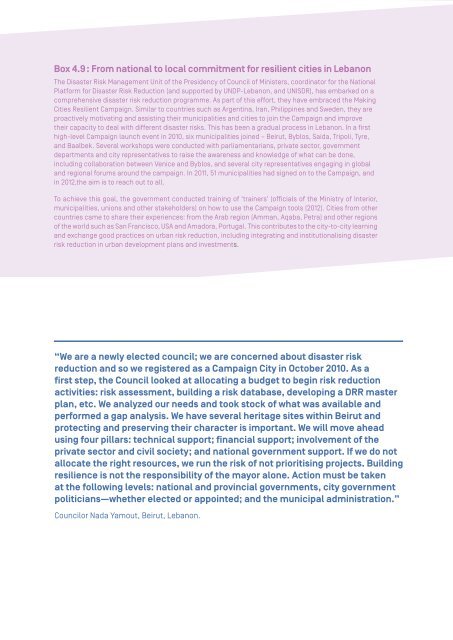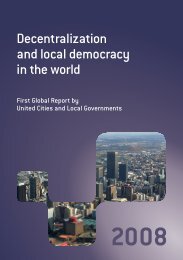Making Cities Resilient Report 2012
Making Cities Resilient Report 2012
Making Cities Resilient Report 2012
Create successful ePaper yourself
Turn your PDF publications into a flip-book with our unique Google optimized e-Paper software.
CHAPTER 4 | What are local governments doing to build resilience<br />
Box 4.9 : From national to local commitment for resilient cities in Lebanon<br />
The Disaster Risk Management Unit of the Presidency of Council of Ministers, coordinator for the National<br />
Platform for Disaster Risk Reduction (and supported by UNDP-Lebanon, and UNISDR), has embarked on a<br />
comprehensive disaster risk reduction programme. As part of this effort, they have embraced the <strong>Making</strong><br />
<strong>Cities</strong> <strong>Resilient</strong> Campaign. Similar to countries such as Argentina, Iran, Philippines and Sweden, they are<br />
proactively motivating and assisting their municipalities and cities to join the Campaign and improve<br />
their capacity to deal with different disaster risks. This has been a gradual process in Lebanon. In a first<br />
high-level Campaign launch event in 2010, six municipalities joined – Beirut, Byblos, Saida, Tripoli, Tyre,<br />
and Baalbek. Several workshops were conducted with parliamentarians, private sector, government<br />
departments and city representatives to raise the awareness and knowledge of what can be done,<br />
including collaboration between Venice and Byblos, and several city representatives engaging in global<br />
and regional forums around the campaign. In 2011, 51 municipalities had signed on to the Campaign, and<br />
in <strong>2012</strong>,the aim is to reach out to all.<br />
To achieve this goal, the government conducted training of ‘trainers’ (officials of the Ministry of Interior,<br />
municipalities, unions and other stakeholders) on how to use the Campaign tools (<strong>2012</strong>). <strong>Cities</strong> from other<br />
countries came to share their experiences: from the Arab region (Amman, Aqaba, Petra) and other regions<br />
of the world such as San Francisco, USA and Amadora, Portugal. This contributes to the city-to-city learning<br />
and exchange good practices on urban risk reduction, including integrating and institutionalising disaster<br />
risk reduction in urban development plans and investments.<br />
“We are a newly elected council; we are concerned about disaster risk<br />
reduction and so we registered as a Campaign City in October 2010. As a<br />
first step, the Council looked at allocating a budget to begin risk reduction<br />
activities: risk assessment, building a risk database, developing a DRR master<br />
plan, etc. We analyzed our needs and took stock of what was available and<br />
performed a gap analysis. We have several heritage sites within Beirut and<br />
protecting and preserving their character is important. We will move ahead<br />
using four pillars: technical support; financial support; involvement of the<br />
private sector and civil society; and national government support. If we do not<br />
allocate the right resources, we run the risk of not prioritising projects. Building<br />
resilience is not the responsibility of the mayor alone. Action must be taken<br />
at the following levels: national and provincial governments, city government<br />
politicians—whether elected or appointed; and the municipal administration.”<br />
Councilor Nada Yamout, Beirut, Lebanon.<br />
<strong>Making</strong> <strong>Cities</strong> <strong>Resilient</strong> <strong>Report</strong> <strong>2012</strong> | 57

















